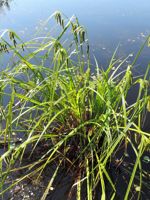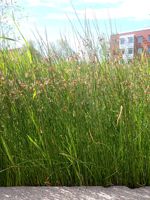Mon-Fri 9am - 5pm Mountain time
Cyperus-like Sedge vs Baltic Rush
Carex pseudocyperus
Juncus balticus
CUSTOM GROW
CUSTOM GROW
Cyperus-like Sedge is a native perennial sedge found in wetlands, marshes, swamps, and along shorelines. Classified as an obligate wetland species, it grows in dense clumps that thrive in saturated soils, helping stabilize wet ground and protect shorelines. These colonies also provide cover for wildlife, while the seeds may be eaten by waterfowl and other birds. It is well-suited to wetland restoration, waterside and riparian zone plantings, and naturalization projects.
Its ornamental appeal comes from the contrast between the upright male floral spikes at the top of the stems and the long, drooping female floral spikes that hang below. These seed spikes resemble those of Cyperus species, giving the plant its common name and making it an attractive addition to naturalized plantings.
Baltic Rush is a widespread native perennial rush that forms dense clumps of upright, cylindrical stems. Well adapted to saturated soils, it is common in wetlands, streambanks, and riparian zones, and is tolerant of both fresh and saline conditions. Hardy and low-maintenance, Baltic Rush contributes to soil stabilization and enhances wetland habitats.
It offers cover for small animals, nesting habitat for birds, and limited forage for livestock when young and tender. Its dense growth and rhizome networks add structural diversity that supports wetland ecosystems, making it well-suited for riparian planting, shoreline stabilization, wetland restoration, and reclamation projects.

